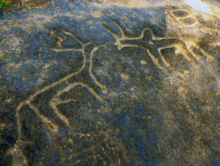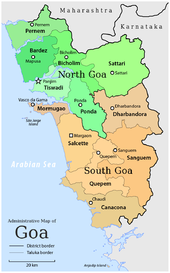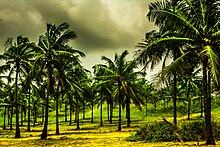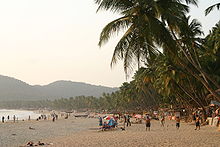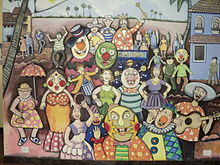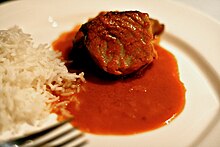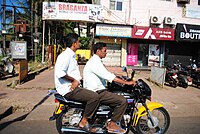GOA<INDIA>
| Goa | ||
|---|---|---|
| State | ||
| ||
 Location of Goa in India | ||
 Map of Goa | ||
Coordinates (Panaji):  15.498605°N 73.829262°E 15.498605°N 73.829262°E | ||
| Country | ||
| Established | 30 May 1987 | |
| Capital | Panaji | |
| Largest city | Vasco da Gama | |
| Districts | 2 | |
| Government | ||
| • Body | Government of Goa | |
| • Governor | Mridula Sinha | |
| • Chief Minister | Manohar Parrikar (BJP) | |
| • Legislature | Unicameral (40 seats) | |
| • Parliamentary constituency | 2 | |
| • High Court | Mumbai High Court – Panaji, Goa Bench | |
| Area | ||
| • Total | 3,702 km2 (1,429 sq mi) | |
| Area rank | 29th | |
| Population (2011) | ||
| • Total | 1,457,723 | |
| • Rank | 26th | |
| • Density | 390/km2 (1,000/sq mi) | |
| Demonym(s) | Goan | |
| Time zone | IST (UTC+05:30) | |
| ISO 3166 code | IN-GA | |
| HDI | ||
| HDI rank | 3rd (2005) | |
| Literacy | 88.70% (3rd) | |
| Official languages | Konkani[1] | |
Goa /ˈɡoʊ.ə/ ( listen) is a state in India within the coastal region known as the Konkan in Western India. It is bounded by Maharashtra to the north and Karnataka to the east and south, with the Arabian Sea forming its Western coast. It is India's smallest state by area and the fourth smallest by population. Goa has highest GDP per capita among all Indian states, that is two and a half times that of the country.[3] It was ranked the best placed state by the "Eleventh Finance Commission" for its infrastructure and ranked on top for the best quality of life in India by the National Commission on Population based on the 12 Indicators.[3]
listen) is a state in India within the coastal region known as the Konkan in Western India. It is bounded by Maharashtra to the north and Karnataka to the east and south, with the Arabian Sea forming its Western coast. It is India's smallest state by area and the fourth smallest by population. Goa has highest GDP per capita among all Indian states, that is two and a half times that of the country.[3] It was ranked the best placed state by the "Eleventh Finance Commission" for its infrastructure and ranked on top for the best quality of life in India by the National Commission on Population based on the 12 Indicators.[3]
Panaji is the state's capital, while Vasco da Gama is its largest city. The historic city of Margao still exhibits the cultural influence of the Portuguese, who first landed in the early 16th century as merchants and conquered it soon thereafter. Goa is a former Portuguese province; the Portuguese overseas territory of Portuguese India existed for about 450 years until it was annexed by India in 1961.[4][5]
Goa is visited by large numbers of international and domestic tourists each year for its beaches, places of worship and world heritage architecture. It has rich flora and fauna, owing to its location on the Western Ghats range, a biodiversityhotspot.
Etymology
In ancient literature, Goa was known by many names, such as Gomanchala, Gopakapattana, Gopakapattam, Gopakapuri, Govapuri, Govem, and Gomantak.[6] In the 3rd century BC, Goa was known as Aparantha and is mentioned by the Greek geographer Ptolemy. In the 13th century, the Greeks referred to Goa as Nelkinda. Other historical names for Goa are Sindapur, Sandabur, and Mahassapatam.[7]
History
Main article: History of Goa
Goa's history goes back 20,000–30,000 years. The rock art engravings exhibit the earliest traces of human life in India.[8]:p.254 Upper Paleolithic or Mesolithic rock art engravings have been found on the bank of the river Kushavati at Usgalimal.[9] Petroglyphs, cones, stone-axe, and choppers dating to 10,000 years ago have been found in many places in Goa, such as Kazur, Mauxim, and the Mandovi-Zuari basin.[10] Evidence of Palaeolithic life is seen at Dabolim, Adkon, Shigao, Fatorpa, Arli, Maulinguinim, Diwar, Sanguem, Pilerne, and Aquem-Margaon etc. Difficulty in carbon dating the laterite rock compounds poses a problem for determining the exact time period.[11]
Early Goan society underwent radical change when Indo-Aryan and Dravidian migrants amalgamated with the aboriginal locals, forming the base of early Goan culture.[12]
In the 3rd century BC, Goa was part of the Maurya Empire, ruled by the Buddhist emperor, Ashoka of Magadha. Buddhist monks laid the foundation of Buddhism in Goa. Between the 2nd century BC and the 6th century AD, Goa was ruled by the Bhojas of Goa. Chutus of Karwar also ruled some parts as feudatories of the Satavahanas of Kolhapur (2nd century BC to the 2nd century AD), Western Kshatrapas(around 150 AD), the Abhiras of Western Maharashtra, Bhojas of the Yadav clans of Gujarat, and the Konkan Mauryas as feudatories of the Kalachuris.[13] The rule later passed to the Chalukyas of Badami, who controlled it between 578 and 753, and later the Rashtrakutas of Malkhed from 753 to 963. From 765 to 1015, the Southern Silharas of Konkan ruled Goa as the feudatories of the Chalukyas and the Rashtrakutas.[14] Over the next few centuries, Goa was successively ruled by the Kadambas as the feudatories of the Chalukyas of Kalyani. They patronised Jainism in Goa.[15]
In 1312, Goa came under the governance of the Delhi Sultanate. The kingdom's grip on the region was weak, and by 1370 it was forced to surrender it to Harihara I of the Vijayanagara empire. The Vijayanagara monarchs held on to the territory until 1469, when it was appropriated by the Bahmani sultans of Gulbarga. After that dynasty crumbled, the area fell into the hands of the Adil Shahis of Bijapur, who established as their auxiliary capital the city known under the Portuguese as Velha Goa (or Old Goa).[16]
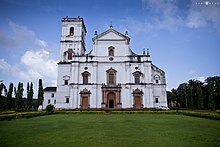
The Se Cathedral at Old Goa, an example of Portuguese architecture and one of the largest churches in Asia.
In 1510, the Portuguese defeated the ruling Bijapur sultan Yousuf Adil Shah with the help of a local ally, Timayya. They set up a permanent settlement in Velha Goa. This was the beginning of Portuguese rule in Goa that would last for four and a half centuries, until its annexation in 1961.[citation needed]
In 1843 the Portuguese moved the capital to Panaji from Velha Goa. By the mid-18th century, Portuguese Goa had expanded to most of the present-day state limits. Simultaneously the Portuguese lost other possessions in India until their borders stabilised and formed the Estado da Índia Portuguesa or State of Portuguese India, of which Goa was the largest territory.[citation needed]
After India gained independence from the British in 1947, India requested that Portuguese territories on the Indian subcontinent be ceded to India. Portugal refused to negotiate on the sovereignty of its Indian enclaves. On 19 December 1961, the Indian Army began military operations with Operation Vijay resulting in the annexation of Goa, Daman, and Diu into the Indian union. Goa, along with Daman and Diu, was organised as a centrally administered union territory of India. On 30 May 1987, the union territory was split, and Goa was made India's twenty-fifth state, with Daman and Diu remaining a union territory.[citation needed]
Geography and climate
Geography
Goa encompasses an area of 3,702 km2 (1,429 sq mi). It lies between the latitudes 14°53′54″ N and 15°40′00″ N and longitudes 73°40′33″ E and 74°20′13″ E.
Goa is a part of the coastal country known as the Konkan, which is an escarpment rising up to the Western Ghats range of mountains, which separate it from the Deccan Plateau. The highest point is the Sonsogor, with an altitude of 1,167 metres (3,829 ft). Goa has a coastline of 101 km (63 mi).
Goa's seven major rivers are the Zuari, Mandovi, Terekhol, Chapora, Galgibag, Kumbarjua canal, Talpona and the Sal.[17] The Zuari and the Mandovi are the most important rivers, interspaced by the Kumbarjua canal, forming a major estuarine complex.[17] These rivers are fed by the Southwest monsoon rain and their basin covers 69% of the state's geographical area.[17] These rivers are some of the busiest in India. Goa has more than 40 estuarine, eight marine, and about 90 riverine islands. The total navigable length of Goa's rivers is 253 km (157 mi). Goa has more than 300 ancient water-tanks built during the rule of the Kadamba dynasty and over 100 medicinal springs.
The Mormugao harbour on the mouth of the River Zuari is one of the best natural harbours in South Asia.
Most of Goa's soil cover is made up of laterites rich in ferric-aluminium oxides and reddish in colour. Further inland and along the riverbanks, the soil is mostly alluvialand loamy. The soil is rich in minerals and humus, thus conducive to agriculture. Some of the oldest rocks in the Indian subcontinent are found in Goa between Molemand Anmod on Goa's border with Karnataka. The rocks are classified as Trondjemeitic Gneiss estimated to be 3,600 million years old, dated by rubidium isotope dating. A specimen of the rock is exhibited at Goa University.
Climate
Goa features a tropical monsoon climate under the Köppen climate classification. Goa, being in the tropical zone and near the Arabian Sea, has a hot and humid climate for most of the year. The month of May is usually the hottest, seeing daytime temperatures of over 35 °C (95 °F) coupled with high humidity. The state's three seasons are: Southwest monsoon period (June – September), post monsoon period (October – January) and fair weather period (February – May).[17] Over 90% of the average annual rainfall (120 inches) is received during the monsoon season.[17]
Subdivisions
| This section does not cite any sources. Please help improve this section by adding citations to reliable sources. Unsourced material may be challenged and removed. (December 2016) (Learn how and when to remove this template message) |
Main article: Districts of Goa
See also: List of cities and towns in Goa
The state is divided into two districts: North Goa and South Goa. Each district is administered by a district collector, appointed by the Indian government.
Panaji is the headquarters of North Goa district and is also the capital of Goa.
North Goa is further divided into three subdivisions – Panaji, Mapusa, and Bicholim; and five taluks – Ilhas de Goa (Tiswadi), Bardez(Mapusa), Pernem, Bicholim, and Sattari (Valpoi),
Margão is the headquarters of South Goa district.
South Goa is further divided into five subdivisions – Ponda, Mormugao (Vasco da Gama), Margao, Quepem, and Dharbandora; and seven taluks – Ponda, Mormugao, Salcete (Margao), Quepem, and Canacona (Chaudi), Sanguem, and Dharbandora. (Ponda Taluka shifted from North Goa to South Goa in January 2015).
Goa's major cities include Vasco da Gama, Margão, Panaji, Mapusa and Ponda.
Panaji is the only Municipal Corporation in Goa.
There are thirteen Municipal Councils: Margao, Mormugao (including Vasco da Gama), Pernem, Mapusa, Bicholim, Sanquelim, Valpoi, Ponda, Cuncolim, Quepem, Curchorem, Sanguem, and Canacona.
Government and politics
Main article: Government of Goa
The politics of Goa are a result of the uniqueness of this region due to 450 years of Portuguese rule, in comparison to three centuries of British colonialism experienced by the rest of India. The Indian National Congresswas unable to achieve electoral success in the first two decades after the State's incorporation into India.[20]Instead, the state was dominated by the communal politics of the Maharashtrawadi Gomantak Party and the United Goans Party.[21]
Government
In the Parliament of India, Goa has two seats in the Lok Sabha (House of the People), one representing each district, and one seat in the Rajya Sabha (Council of the States).
Goa's administrative capital is Panaji in English, Pangim in Portuguese, and Ponjê in the local language. It lies on the left bank of the Mandovi. The seat of the Goa assembly is in Porvorim, across the Mandovi from Panaji. As the state comes under the Bombay High Court, Panaji has a bench of it. Unlike other states, which follow the British Indian model of civil laws framed for individual religions, the Portuguese Goa Civil Code, a uniform code based on the Napoleonic code, has been retained in Goa.
Goa has a unicameral legislature of 40 members, headed by a Speaker. The Chief Minister heads the executive, which comprises the party or coalition elected with a majority in the legislature. The Governor, the head of the state, is appointed by the President of India. After having stable governance for nearly thirty years up to 1990, Goa is now notorious for its political instability having seen fourteen governments in the span of the fifteen years between 1990 and 2005.[22] In March 2005 the assembly was dissolved by the Governor and President's Rule was declared, which suspended the legislature. A by-election in June 2005 saw the Indian National Congress coming back to power after winning three of the five seats that went to polls. The Congress Party and the Bharatiya Janata Party (BJP) are the two largest parties in the state. In the assembly poll of 2007, the INC-led coalition won and formed the government.[23] In the 2012 Vidhan Sabha Elections, the Bharatiya Janata Party along with the Maharashtrawadi Gomantak Party won a clear majority, forming the new government with Manohar Parrikar as the Chief Minister. Other parties include the United Goans Democratic Party, the Nationalist Congress Party.[24]In the 2017 assembly elections, the Indian National Congress gained the maximum number of seats with the BJP coming in second. However, no party was able to gain a majority in the 40 member house. The BJP was invited to form the Government by Governor Mridula Sinha. The Congress claimed the use of money power on the part of the BJP and moved the Supreme Court. However, the Manohar Parikkar led Government was able to prove its majority in the Supreme Court mandated floor test.[25][26][27]
Flora and fauna
Main article: Flora and fauna of Goa
Equatorial forest cover in Goa stands at 1,424 km2 (549.81 sq mi),[6] most of which is owned by the government. Government owned forest is estimated at 1,224.38 km2 (472.74 sq mi) whilst private is given as 200 km2 (77.22 sq mi). Most of the forests in the state are located in the interior eastern regions of the state. The Western Ghats, which form most of eastern Goa, have been internationally recognised as one of the biodiversity hotspots of the world. In the February 1999 issue of National Geographic Magazine, Goa was compared with the Amazon and the Congo basins for its rich tropical biodiversity.[citation needed]
Goa's wildlife sanctuaries boast of more than 1512 documented species of plants, over 275 species of birds, over 48 kinds of animals and over 60 genera of reptiles.[28]
Goa is also known for its coconut cultivation. The coconut tree has been reclassified by the government as a palm (like a grass), enabling farmers and real estate developers to clear land with fewer restrictions.
Rice is the main food crop with pulses (legume), Ragi (Finger Millet) and other food crops are also grown. Main cash crops are coconut, cashewnut, arecanut, sugarcane and fruits like pineapple, mango and banana.[6] Goa's state animal is the Gaur, the state bird is the Ruby Throated Yellow Bulbul, which is a variation of Black-crested Bulbul, and the state tree is the Asan.
The important forests products are bamboo canes, Maratha barks, chillar barks and the bhirand. Coconut trees are ubiquitous and are present in almost all areas of Goa barring the elevated regions. A large number of deciduous trees, such as teak, Sal tree, cashew and mango trees are present. Fruits include jackfruit, mango, pineapple and "black-berry" ("podkoam" in Konkani language). Goa's forests are rich with medicinal plants.

Rice paddies are common in rural Goa.
Foxes, wild boar and migratory birds are found in the jungles of Goa. The avifauna (bird species) includes kingfisher, myna and parrot. Numerous types of fish are also caught off the coast of Goa and in its rivers. Crab, lobster, shrimp, jellyfish, oysters and catfish are the basis of the marine fishery. Goa also has a high snake population. Goa has many famous "National Parks", including the renowned Salim Ali Bird Sanctuary on the island of Chorão. Other wildlife sanctuaries include the Bondla Wildlife Sanctuary, Molem Wildlife Sanctuary, Cotigao Wildlife Sanctuary, Madei Wildlife Sanctuary, Netravali Wildlife Sanctuary, and Mahaveer Wildlife Sanctuary.
Goa has more than 33% of its geographic area under government forests (1224.38 km²) of which about 62% has been brought under Protected Areas (PA) of Wildlife Sanctuaries and National Park. Since there is a substantial area under private forests and a large tract under cashew, mango, coconut, etc. plantations, the total forest and tree cover constitutes 56.6% of the geographic area.
Economy
| Gross State Domestic Product (in millions of Rupees)[29] | |
| Year | GSDP |
|---|---|
| 1980 | 3,980 |
| 1985 | 6,550 |
| 1990 | 12,570 |
| 1995 | 33,190 |
| 2000 | 76,980 |
| 2010 | 150,000 |
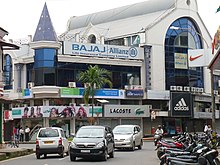
Commercial area in Panaji.
Goa's state domestic product for 2007 is estimated at $3 billion at current prices. Goa is one of India's richest states with the highest GDP per capita – two and a half times that of the country – with one of its fastest growth rates: 8.23% (yearly average 1990–2000).[30] Tourism is Goa's primary industry: it gets 12%[31] of foreign tourist arrivals in India. Goa has two main tourist seasons: winter and summer. In winter, tourists from abroad (mainly Europe) come, and summer (which, in Goa, is the rainy season) sees tourists from across India.
The land away from the coast is rich in minerals and ores, and mining forms the second largest industry. Iron, bauxite, manganese, clays, limestone and silica are mined. The Marmagao port handled 31.69 million tonnes of cargo last year, which was 39% of India's total iron ore exports. Sesa Goa (now owned by Vedanta Resources) and Dempo are the lead miners. Rampant mining has been depleting the forest cover as well as posing a health hazard to the local population. Corporations are also mining illegally in some areas.
Agriculture, while of shrinking importance to the economy over the past four decades, offers part-time employment to a sizeable portion of the populace. Rice is the main agricultural crop, followed by areca, cashew and coconut. Fishing employs about 40,000 people, though recent official figures indicate a decline of the importance of this sector and also a fall in catch, due perhaps, to traditional fishing giving way to large-scale mechanised trawling.
Medium scale industries include the manufacturing of pesticides, fertilisers, tyres, tubes, footwear, chemicals, pharmaceuticals, wheat products, steel rolling, fruits and fish canning, cashew nuts, textiles, brewery products.
Currently there are 16 planned SEZs in Goa. The Goa government has recently decided to not allow any more special economic zones (SEZs) in Goa after strong opposition to them by political parties and the powerful Goa Catholic Church.[32]
Goa is also notable for its low priced beer, wine and spirits prices due to its very low excise duty on alcohol. Another source of cash inflow into the state is remittance from many of its citizens who work abroad to their families. It is said to have some of the largest bank savings in the country.
Population
Demographics
See also: Goans
A native of Goa is called a Goan in English, Goenkar in Konkani, goês or goesa in Portuguese and Govekar in Marathi. The local Indian Christians were called "indiacatos" and the mixed population, mestiços by the Portuguese. Goa has a population of 1.459 million residents,[33] making it India's fourth smallest (after Sikkim, Mizoram and Arunachal Pradesh). The population has a growth rate of 8.23% per decade. There are 394 people for each square kilometre of land which is higher than national average 382 per km2. Goa is the state with highest proportion of urban population with 62.17% of the population living in urban areas. The sex ratio is 973 females to 1000 males. The birth rate is 15.70 per 1,000 people in 2007. Goa also is the state with lowest proportion of Scheduled Tribes at 0.04%.[34]
Languages
The Goa, Daman and Diu Official Language Act, 1987 makes Konkani in the Devanagari script the sole official language of Goa, but provides that Marathi may also be used "for all or any of the official purposes". Portuguese was the sole official language during Portuguese colonial rule. It is now, however, mostly spoken by only the elderly Portuguese-educated populations and is no longer an official language[citation needed]. There is a now a growing interest in Portuguese with the organization of several contests and programs to promote the same[citation needed]. The Government also has a policy of replying in Marathi to correspondence received in Marathi.[35] Whilst there have been demands for according Konkani in the Roman script official status in the state, there is widespread support for keeping Konkani as the sole official language of Goa.[36] It is however notable to mention that the entire liturgy and communication of the Catholic church in Goa is done solely in the Roman script of Konkani.
Konkani is spoken as a native language by about 61% of the people in the state but almost all Goans can speak and understand Konkani. Other linguistic minorities in the state as per the 2001 census are speakers of Marathi (19%), Kannada (7%), Hindi (5%), and Urdu (4%).[37] With the exception of Konkani, English, Portuguese and Marathi, all other mentioned languages are primarily migrant-based languages, natively spoken in other Indian states.
Religion
According to the 2011 census, in a population of 1,458,545 people, 66.1% were Hindu, 25.1% were Christian, and 8.3% were Muslim. Smaller minorities of about 0.1% each followed Sikhism, Buddhism, or Jainism.[39]
Due to the economic decline of the Estado da India from the eighteenth century, there was a large scale migration of Goan Catholics. The local Indian Christians were called "indiacatos" and the mixed population, mestiços by the Portuguese. The population moved from 64.5% Christians and 35% Hindus in 1851 to 50% Christians and 50% Hindus in 1900, with a steady increase in the Hindu proportion from then onwards.[40]
The Catholics in Goa state and Daman and Diu union territory are served by the Metropolitan Roman Catholic Archdiocese of Goa and Daman, the primatial see of India, in which the titular Patriarchate of the East Indies is vested.
Tourism
See also: Tourism in Goa
Tourism is generally focused on the coastal areas of Goa, with decreased tourist activity inland. In 2010, there were more than two million tourists reported to have visited Goa, about 1.2 million of whom were from abroad.[41] As of 2013 Goa was a destination of choice for Indian and foreign tourists, particularly Britons and Russians, with limited means who wanted to party. The state was hopeful that changes could be made which would attract a more upscale demographic.[42] Goa also stands 6th in the Top 10 Nightlife cities in the world in a National Geographic Book.[43] One of the biggest tourist attractions in Goa is water sports. Beaches like Baga and Calangute offer jet-skiing, parasailing, banana boat rides, water scooter rides and more.
Over 450 years of Portuguese rule and the influence of the Portuguese culture presents to visitors to Goa a different cultural environment than what is found elsewhere in India. Goa is often described as a fusion between Eastern and Western culture with Portuguese culture having a dominant position in the state be it in its architectural, cultural or social settings. The state of Goa is famous for its excellent beaches, churches, and temples. The Bom Jesus Cathedral, Fort Aguada and a new wax museum on Indian history, culture and heritage in Old Goa are other tourism destinations.
Historic sites and neighbourhoods
Goa has two World Heritage Sites: the Bom Jesus Basilica[44] and churches and convents of Old Goa. The Basilica holds the mortal remains of St. Francis Xavier, regarded by many Catholics as the patron saint of Goa (the patron of the Archdiocese of Goa is actually Saint Joseph Vaz). These are both Portuguese-era monuments and reflect a strong European character. The relics are taken down for veneration and for public viewing, as per the prerogative of the Church in Goa, not every ten or twelve years as popularly thought and propagated. The last exposition was held in 2014.[45]
Goa also has the Sanctuary of Saint Joseph Vaz in Sancoale. Pilar monastery which holds novenas of Venerable Padre Agnelo Gustavo de Souza from 10 November to 20 November yearly. There is also a claimed Marian Apparition at the Church of Saints Simon and Jude at Batim Ganxim, near Pilar, where a number of Goans and non resident Goans visit. There is also the statue of the bleeding Jesus on the Crucifix at the Santa Monica Convent in Velha Goa. There are a number of churches (Igorzo), like the Baroque styled Nixkollounk Gorb-Sombhov Saibinnich Igorz (Church of the Our Lady of Immaculate Conception) in Panaji, the Gothic styled Mater Dei (Dêv Matechi Igorz/ Mother of God) church in Saligao and each church having its own style and heritage, besides Kopelam/ Irmidi (Chapels). The Velhas Conquistas regions are also known for its Goa-Portuguese style architecture. There are many forts in Goa such as Tiracol, Chapora, Corjuem, Aguada, Reis Magos, Nanus, Mormugao, Fort Gaspar Dias and Cabo de Rama.[citation needed]
In many parts of Goa, mansions constructed in the Indo-Portuguese style architecture still stand, though in some villages, most of them are in a dilapidated condition. Fontainhas in Panaji has been declared a cultural quarter, showcasing the life, architecture and culture of Goa. Some influences from the Portuguese era are visible in some of Goa's temples, notably the Shanta Durga Temple, the Mangueshi Temple and the Mahalasa Temple, although after 1961, many of these were demolished and reconstructed in the indigenous Indian style.[citation needed]
Museums and science centre
Goa also has a few museums, the two important ones being Goa State Museum and the Naval Aviation Museum. The aviation museum is one among three of its kind in the India, the other two being in Delhi and Bengaluru. Also, a place not well known to tourists is the Goa Science Centre, which is located in Miramar, Panaji.[46] The National Institute of Oceanography (NIO) is also located in Goa at Dona Paula.[47]
Culture
Main article: Culture of Goa
Having been a Portuguese territory for over 450 years, Goa's culture is an interesting amalgamation of both Eastern and Western styles, with the latter having a more dominant role. The tableau of Goa showcases religious harmony by focusing on the Deepastambha, the Cross and Ghode Modni followed by a chariot. Western royal attire of kings is as much part of Goa's cultural heritage as are regional dances performed depicting a unique blend of different religions and cultures of this State. Prominent local festivals are Christmas, Easter, Carnival, Diwali, Shigmo, Chavoth, Samvatsar Padvo, Dasara etc. The Goan Carnival and Christmas-new year celebrations are well known to attract a large number of tourists.
The Gomant Vibhushan Award, the highest civilian honour of the State of Goa, is given annually by Government of Goa since 2010.[48][49]
Dance and music
Traditional Goan art forms are Dekhnni, Fugdi, Corridinho, Mando, Dulpod and Fado.[50] Goan Catholics are fond of social gatherings and Tiatr (Teatro). As part of its Portuguese history, music is an integral part of Goan homes. It is often said that "Goans are born with music and sport". Western musical instruments like the Piano, guitars and violins are widely used in most religious and social functions of the Catholics.
Goan Hindus are very fond of Natak, Bhajan and Kirtan.[citation needed] Many famous Indian classical singers hail from Goa, including Mogubai Kurdikar, Kishori Amonkar, Kesarbai Kerkar, Jitendra Abhisheki and Pandit Prabhakar Karekar.[citation needed]
Goa is also known as the origin of Goa trance.
Theatre
Natak, Tiatr (most popular) and Jagor are the chief forms of Goa's traditional performance arts. Other forms are Ranmale, Dashavatari, Kalo, Goulankala, Lalit, Kala and Rathkala.[citation needed] Stories from the Ramayana and the Mahabharata along with more modern social subjects are narrated with song and dance.[51][52]
"Jagor", the traditional folk dance-drama, is performed by the Hindu Kunbi and Christian Gauda community of Goa, to seek the Devine Grace for protection and prosperity of the crop. Literal meaning of Jagor is “jagran” or wakeful nights. The strong belief is that the night long performance, awakens the deities once a year and they continue to remain awake throughout the year guarding the village.
Perni Jagor is the ancient mask dance – drama of Goa, performed by Perni families, using well crafted and painted wooden masks, depicting various animals, birds, super natural power, deities, demons and social characters.
Gauda Jagor, is an impression of social life, that displays all the existing moods and modes of human characters. It is predominantly based on three main characters, Gharasher, Nikhandar and Parpati wearing shining dress and headgears. The performance is accompanied by vibrant tunes of Goan folk instruments like Nagara/Dobe, Ghumat, Madale and Kansale.
In some places, Jagor performances are held with participation of both Hindus and Christian community, whereby, characters are played by Hindus and musical support is provided by Christian artistes.[53]
Tiatr (Teatro) and its artists play a major role in keeping the Konkani language & music alive. Tiatr's are conducted solely in the Roman script of Konkani as it is primarily a Christian community based act. They are played in scenes with music at regular intervals, the scenes are portrayals of daily life and are known to depict social and cultural scenarios. Tiatrs are regularly held especially on weekends mainly at Kala Academy, Panaji, Pai Tiatrist Hall at Ravindra Bhavan, Margao and most recent shows have also started at the new Ravindra Bhavan, Baina, Vasco. Western Musical Instruments such as Drums, bass, Keyboards, Trumpets etc. are part of the show and most of them are played acoustically.[citation needed] It is one of Goa's few art forms that is renowned across the world with performances popular among Goans in the Middle-East, Americas and Europe.
Konkani cinema
Konkani cinema is an Indian film industry, where films are made in the Konkani language, which is spoken mainly in the Indianstates of Goa, Maharashtra and Karnataka and to a smaller extent in Kerala. Konkani films have been produced in Goa, Karnataka, Maharashtra and Kerala.[54]
The first full length Konkani film was Mogacho Anvddo, released on 24 April 1950, and was produced and directed by A. L.Jerry Braganza, a native of Mapusa, under the banner of ETICA Pictures.[55][56] Hence, 24 April is celebrated as Konkani Film Day.[57]
Konkani film Paltadcho manis has been included in the world's best films of 2009 list.[58]
Konkani films are eligible for the National Film Award for Best Feature Film in Konkani. The most commercially successful Konkani film (as of June 2011) is O Maria directed by Rajendra Talak.[59]
In 2012, the whole new change adopted in Konkani Cinema by introducing Digital Theatrical Film "The Victim" directed by Milroy Goes.[60]
Some old Konkani films are Sukhachem Sopon, Amchem Noxib, Nirmonn, Mhoji Ghorkarn, Kortubancho Sonvsar, Jivit Amchem Oxem, Mog ani Moipas, Bhuierantlo Munis, Suzanne, Boglantt, Padri and Bhogsonne. Ujwadu is a 2011 Konkani film directed by Kasargod Chinna and produced by KJ Dhananjaya and Anuradha Padiyar.
Food
Rice with fish curry (xit koddi in Konkani) is the staple diet in Goa. Goan cuisine is famous for its rich variety of fish dishes cooked with elaborate recipes. Coconut and coconut oil are widely used in Goan cooking along with chili peppers, spices, and vinegar is used in the Catholic cuisine, giving the food a unique flavour. The Goan cuisine is heavily influenced by Portuguese cuisine.
Goan food may be divided into Goan Catholic and Goan Hindu cuisine with each showing very distinct tastes, characteristics, and cooking styles. Pork dishes such as Vindalho, Xacuti, chouriço, and Sorpotel are cooked for major occasions among the Goan Catholics. An exotic Goan vegetable stew, known as Khatkhate, is a very popular dish during the celebrations of festivals, Hindu and Christian alike. Khatkhate contains at least five vegetables, fresh coconut, and special Goan spices that add to the aroma.
Sannas, Hitt, are variants of idli and Polle, Amboli, and Kailoleo are variants of dosa; all are native to Goa. A rich egg-based, multi-layered sweet dish known as bebinca is a favourite at Christmas.
There are some places in Goa which are famous for Goa's traditional & special cuisines.
The most popular alcoholic beverage in Goa is feni; cashew feni is made from the fermentation of the fruit of the cashew tree, while coconut feni is made from the sap of toddy palms.[61] Goa also has a rich wine culture.[62][63]
Architecture

The House of the Seven Gables in Margao
The architecture of Goa is a combination of Indian, Islamic and Portuguese styles. Since the Portuguese ruled for four centuries, many churches and houses bear a striking element of the Portuguese style of architecture. Goan Hindu houses do not show any Portuguese influence, though the modern temple architecture is an amalgam of original Goan temple style with Dravidian, Hemadpanthi, Islamic, and Portuguese architecture.[64] The original Goan temple architecture fell into disuse as the temples were demolished by the Portuguese and the Sthapati known as Thavayi in Konkani were converted to Christianity though the wooden work and the Kavi murals can still be seen.[65] (see:Goa:Hindu temples and deities by Rui Gomes Pereira).
Media and communication
| This section does not cite any sources. Please help improve this section by adding citations to reliable sources. Unsourced material may be challenged and removed. (December 2016) (Learn how and when to remove this template message) |
Main article: Media in Goa
Goa is served by almost all television channels available in India. Channels are received through cable in most parts of Goa. In the interior regions, channels are received via satellite dishes. Doordarshan, the national television broadcaster, has two free terrestrial channels on air.[citation needed]
DTH (Direct To Home) TV services are available from Dish TV, Videocon D2H, Tata Sky & DD Direct Plus. The All India Radio is the only radio channel in the state that broadcasts on both FM and AM bands. Two AM channels are broadcast, the primary channel at 1287 kHz and the Vividh Bharati channel at 1539 kHz. AIR's FM channel is called FM Rainbow and is broadcast at 105.4 MHz. A number of independent FM radio channels are available, Big FM at 92.7 MHz, Radio Mirchi at 98.3 MHz, and Radio Indigo at 91.9 MHz. There is also an educational radio channel, Gyan Vani, run by IGNOU broadcast from Panaji at 107.8 MHz. In 2006, St Xavier's College, Mapusa, became the first college in the state to launch a campus community radio station "Voice of Xavier's".[citation needed]
Major cellular service operators include Bharti Airtel, Vodafone Essar, Idea Cellular, Telenor, Reliance Infocomm, Tata DoCoMo and BSNL CellOne.
Local publications include the English language O Heraldo (Goa's oldest, once a Portuguese language paper), The Gomantak Times and The Navhind Times. In addition to these, The Times of India and The Indian Express are also received from Mumbai and Bangalore in the urban areas. The Times of India has recently started publication from Goa itself, serving the local population news directly from the state capital. Among the list of officially accredited newspapers are O Heraldo, The Navhind Times and The Gomantak Times in English; Bhaangar Bhuin in Konkani (Devanagari script); and Tarun Bharat, Gomantak, Navprabha, Goa Times, Sanatan Prabhat, Govadoot and Lokmat (all in Marathi). All are dailies. Other publications in the state include Planet Goa (English, monthly), Goa Today (English, monthly), Goan Observer (English, weekly), Vauraddeancho Ixtt (Roman-script Konkani, weekly) Goa Messenger, Vasco Watch, Gulab (Konkani, monthly), Bimb (Devanagari-script Konkani).
Sports
Unlike the rest of India, association football is the most popular sport in Goa and is embedded in Goan culture as a result of the Portuguese influence.[66] Its origins in the state are traced back to 1883 when the visiting Irish priest Fr. William Robert Lyons established the sport as part of a "Christian education".[66][67] On 22 December 1959 the Associação de Futebol de Goa was formed, which continues to administer the game in the state under the new name Goa Football Association.[66] Goa, along with West Bengal and Kerala[66] is the locus of football in India and is home to many football clubs in the national I-League. The state's football powerhouses include Salgaocar Sports Club, Dempo Sports Club, Churchill Brothers, Vasco Sports Club and Sporting Clube de Goa. The first Unity World Cup was held in Goa in 2014. The state's main football stadium, Fatorda Stadium, is located at Margao and also hosts cricket matches.[68]
A number of Goans have represented India in football and six of them, namely Samir Naik, Climax Lawrence, Brahmanand Sankhwalkar, Bruno Coutinho, Mauricio Afonso and Roberto Fernandes have all captained the national team. Goa has its own state football team and league, the Goa Professional League. It is probably the only state in India where cricket is not considered the most important of all sports.
Goa also has its own cricket team. Dilip Sardesai remains the only Goan to date to play international cricket for India.[69]
The Indian Olympic Association (IOA) has won the right to host the Asian Beach Games in 2018.[70]
For more details on this topic, see Goans in sports.
Education
Main article: Education in Goa
Goa had India's earliest educational institutions built with European support. The Portuguese set up seminaries for religious education and parish schools for elementary education. Founded circa 1542 by saint Francis Xavier, Saint Paul's College, Goawas a Jesuit school in Old Goa, which later became a college. St Paul's was once the main Jesuit institution in the whole of Asia. It housed the first printing press in India and published the first books in 1556.
Medical education began in 1801 with the offering of regular medical courses at the Royal and Military Hospital in the old City of Goa. Built in 1842 as the Escola Médico-Cirúrgica de (Nova) Goa (Medical-Surgical School of Goa), Goa Medical College is one of Asia's oldest medical colleges and has one of the oldest medical libraries (since 1845).[71] It houses the largest hospital in Goa and continues to provide medical training to this day.
According to the 2011 census, Goa has a literacy rate of 87%, with 90% of males and 84% of females being literate.[72] Each taluka is made up of villages, each having a school run by the government. Private schools are preferred over government run schools. All schools come under the Goa Board of Secondary & Higher Secondary Education, whose syllabus is prescribed by the state education department. There are also a few schools that subscribe to the all-India ICSE syllabus or the NIOS syllabus. Most students in Goa complete their high school with English as the medium of instruction. Most primary schools, however, use Konkani and Marathi (in private, but government-aided schools). As is the case in most of India, enrolment for vernacular media has seen a fall in numbers in favour of English medium education. As per a report published in The Times of India, 84% of Goan primary schools run without an administrative head.[73]

Carmel College for Women is affiliated to Goa University. It was established more than 50 years to aid in closing the education gender gap.
The best known schools in Goa include Sharada Mandir School in Miramar, St Mary Angels Convent High School in Chinchinim, Perpetual Succour Convent High school, Navelim, Our Lady of the Rosary High School at Dona Paula, Vidya Prabhodini at Porvorim, K.B. Hedgewar High School, the Progress High School, Don Bosco High School, People's High School, Mushtifund High School in Panaji, Saraswat Vidyalaya High School in Mapusa, Sunshine Worldwide school in Old Goa, Shiksha Niketan and Nisha's Playschool in Torda, A. J. de Almeida High School in Ponda, S.S. Samiti's I.V.B.D. High School in Dhawali–Ponda, Vidya Bharati, Mahila And Nutan English High School in Margao, Manovikas in Margao, Loyola High School in Margao, St. Joseph's Institute, Deepvihar High School in Vasco da Gama and Rosary High School in Navelim. Lourdes Convent High School in Saligao.

Goa Medical College, previously called Escola Médico–Cirúrgica de Goa
After ten years of schooling, students join a Higher Secondary school, which offers courses in popular streams such as Science, Arts, Law and Commerce. A student may also opt for a course in vocational studies. Additionally, they may join three-year diploma courses. Two years of college is followed by a professional degree programme. Goa University, the sole university in Goa, is located in Taleigão and most Goan colleges are affiliated to it.
There are six engineering colleges in the state. Goa Engineering College and National Institute of Technology Goa are government funded colleges whereas the private engineering colleges include Don Bosco College of Engineering at Fatorda, Shree Rayeshwar Institute of Engineering and Information Technology at Shiroda, Agnel Institute of Technology and Design (AITD),Assagao, Bardez and Padre Conceicao College of Engineering at Verna. In 2004, BITS Pilani one of the premier institutes in India, inaugurated its second campus, the BITS Pilani Goa Campus, at Zuarinagar near Dabolim.
There are colleges offering pharmacy, architecture and dentistry along with numerous private colleges offering law, arts, commerce and science. There are also two National Oceanographic Science related centres: the National Centre for Antarctic and Ocean Research in Vasco da Gama and the National Institute of Oceanography in Dona Paula.
Goa Institute of Management located at Sanquelim, near Panaji is one of India's premier business schools.
In addition to the engineering colleges, there are government polytechnic institutions in Panaji, Bicholim and Curchorem, and aided institutions like Father Agnel Polytechnic in Verna and the Institute of Shipbuilding Technology in Vasco da Gama which impart technical and vocational training.[74]
Other colleges in Goa include Shri Damodar College of Commerce and Economics, V.V.M's R.M. Salgaocar Higher Secondary School in Margao, G.V.M's S.N.J.A higher secondary school, Don Bosco College, D.M.'s College of Arts, Science and Commerce, St Xavier's College, Carmel College, The Parvatibai Chowgule College, Dhempe College, Damodar College, MES College, S. S. Samiti's Higher Secondary School of Science and Rosary College of Commerce & Arts.
TransportatioN
Air
Goa International Airport, is a civil enclave at INS Hansa, a Naval airfield located at Dabolim near Vasco da Gama. The airport caters to scheduled domestic and international air services. Goa has scheduled international connections to Doha, Dubai, Muscat, Sharjah and Kuwait in the Middle East by airlines like Air Arabia, Air India, GoAir, Indigo, Oman Air, SpiceJet, Jet Airways, JetKonnect and Qatar Airways. The proposed greenfield Mopa Airport will be built at Mopa in Pernem taluka.
Road
Goa's public transport largely consists of privately operated buses linking the major towns to rural areas. Government-run buses, maintained by the Kadamba Transport Corporation, link major routes (like the Panaji–Margao route) and some remote parts of the state. The Corporation owns 15 bus stands, 4 depots and one Central workshop at Porvorim and a Head Office at Porvorim.[75] In large towns such as Panajiand Margao, intra-city buses operate. However, public transport in Goa is less developed, and residents depend heavily on their own transportation, usually motorised two-wheelers and small family cars.
Goa has four National Highways passing through it. NH-66 (ex NH-17) runs along India's west coast and links Goa to Mumbai in the north and Mangalore to the south. NH-4A running across the state connects the capital Panaji to Belgaum in east, linking Goa to cities in the Deccan. The NH-366 (ex NH-17A) connects NH-66 to Mormugao Port from Cortalim. The new NH-566 (ex NH-17B) is a four-lane highway connecting Mormugao Port to NH-66 at Verna via Dabolim Airport, primarily built to ease pressure on the NH-366 for traffic to Dabolim Airport and Vasco da Gama. NH-768 (ex NH-4A) links Panaji and Ponda to Belgaum and NH-4. Goa has a total of 224 km (139 mi) of national highways, 232 km (144 mi) of state highway and 815 kilometres (506 miles) of district highway. National Highways in Goa are among the narrowest in the country and will remain so for the foreseeable future, as the state government has received an exemption that allows narrow national highways. In Kerala, highways are 45 metres (148 feet) wide. In other states National Highways are grade separated highways 60 metres (200 feet) wide with a minimum of four lanes, as well as 6 or 8 lane access-controlled expressways.[76][77]
Hired forms of transport include unmetered taxis and, in urban areas, auto rickshaws. Another form of transportation in Goa is the motorcycle taxi, operated by drivers who are locally called "pilots". These vehicles transport a single pillion rider, at fares that are usually negotiated. Other than buses, "pilots" tend to be the cheapest mode of transport.[78] River crossings in Goa are serviced by flat-bottomed ferry boats, operated by the river navigation department.
Rail
Goa has two rail lines – one run by the South Western Railway and the other by the Konkan Railway. The line run by the South Western Railway was built during the colonial era linking the port town of Vasco da Gama, Goa with Belgaum, Hubli, Karnatakavia Margao. The Konkan Railway line, which was built during the 1990s, runs parallel to the coast connecting major cities on the western coast.
Sea
The Mormugao harbour near the city of Vasco handles mineral ore, petroleum, coal, and international containers. Much of the shipments consist of minerals and ores from Goa's hinterland. Panaji, which is on the banks of the Mandovi, has a minor port, which used to handle passenger steamers between Goa and Mumbai till the late 1980s. There was also a short-lived catamaran service linking Mumbai and Panaji operated by Damania Shipping in the 1990s.

